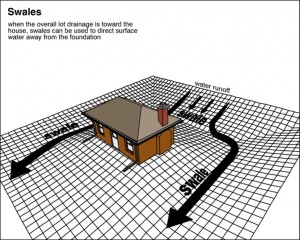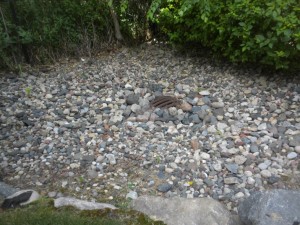 Are swales and culverts used often for drainage?
Are swales and culverts used often for drainage?
Yes they are! Swales are often dug along property lines to direct water to street drains. Most people aren’t aware that there is even a drain there. They don’t take any particular notice of the depression in the soil and think nothing of it, when all of the water between the houses is directed to the storm drain instead of leaving pools on their property.
Take a look at this illustration of a swale and then the photograph of 10 properties that are swaled to a single culvert! What a wonderful solution to getting water off the properties… Maybe!
What if some of the 10 property owners leave trash in their  swale depression, which is washed down to the culvert anytime it rains? Is anyone in the community going to be responsible for seeing that there is no trash building up on the grid during rainfall? Trash or debris building up on the culvert grid can become a very effective plug. A pond can be formed very quickly, behind the culvert opening, in heavy rainfall, which can in turn raise the water table on the surrounding land. Hopefully the drainage designer has allowed for such a possibility and has designed the residential lots, so that a rising water table will not flood the basements of the surrounding homes or cause the sump pumps to be operating continuously.
swale depression, which is washed down to the culvert anytime it rains? Is anyone in the community going to be responsible for seeing that there is no trash building up on the grid during rainfall? Trash or debris building up on the culvert grid can become a very effective plug. A pond can be formed very quickly, behind the culvert opening, in heavy rainfall, which can in turn raise the water table on the surrounding land. Hopefully the drainage designer has allowed for such a possibility and has designed the residential lots, so that a rising water table will not flood the basements of the surrounding homes or cause the sump pumps to be operating continuously.
 Swales are marvelous, but they do require maintenance and supervision. You can’t allow a swale on your property to build up with debris to a point where it causes water to flow onto the neighbor’s property or perhaps in the direction of your own basement. It is simply illegal to allow water to flow off your property on to your neighbors land and I’m sure you don’t want to wake up one morning with a wet basement yourself!
Swales are marvelous, but they do require maintenance and supervision. You can’t allow a swale on your property to build up with debris to a point where it causes water to flow onto the neighbor’s property or perhaps in the direction of your own basement. It is simply illegal to allow water to flow off your property on to your neighbors land and I’m sure you don’t want to wake up one morning with a wet basement yourself!

We would appreciate hearing from you, if you have an opinion or a question on swales. In fact, we would like to hear from you anytime you have a comment or an idea to share on any of these blogs. Communication is a two-way street, so let us hear what is going through your mind.
Doug Hastings
MN Home Inspector, Minneapolis & St. Paul
Kaplan University, Home Inspection Lead Instructor
Rob ‘Pops’ Leslie
Kaplan Professionals, Retired




